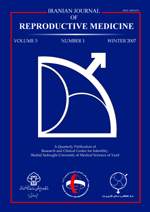
|
International Journal of Reproductive BioMedicine
Research and Clinical Center for Infertility, Shahid Sadoughi University of Medical Sciences of Yazd
ISSN: 1680-6433
EISSN: 1680-6433
Vol. 18, No. 10, 2020, pp. 885-898
|
 Bioline Code: rm20089
Bioline Code: rm20089
Full paper language: English
Document type: Research Article
Document available free of charge
|
|
|
International Journal of Reproductive BioMedicine, Vol. 18, No. 10, 2020, pp. 885-898
| en |
Comparison of chromosomal instability of human amniocytes in primary and long-term cultures in AmnioMAX II and DMEM media: A cross-sectional study
Hoseini, Seyed Mehdi; Montazeri, Fateme; Moghaddam-Matin, Maryam; Bahrami, Ahmad Reza; Meimandi, Hassan Heidarian; Ghasemi-Esmailabad, Saeed & Kalantar, Seyed Mehdi
Abstract
Background: The genomic stability of stem cells to be used in cell therapy and other
clinical applications is absolutely critical. In this regard, the relationship between in
vitro expansion and the chromosomal instability (CIN), especially in human amniotic
fluid cells (hAFCs) has not yet been completely elucidated.
Objective: To investigate the CIN of hAFCs in primary and long-term cultures and two
different culture mediums.
Materials and Methods: After completing prenatal genetic diagnoses (PND) using
karyotype technique and chromosomal analysis, a total of 15 samples of hAFCs from
650 samples were randomly selected and cultured in two different mediums as
AmnioMAX II and DMEM. Then, proliferative cells were fixed on the slide to be used
in standard chromosome G-banding analysis. Also, the senescent cells were screened
for aneuploidy considering 8 chromosomes by FISH technique using two probe sets
including PID I (X-13-18-21) & PID II (Y-15-16-22).
Results: Karyotype and interphase fluorescence in situ hybridization (iFISH) results
from 650 patients who were referred for prenatal genetic diagnosis showed that
only 6 out of them had culture- derived CIN as polyploidy, including mosaic diploid-triploid
and diploid-tetraploid. Moreover, the investigation of aneuploidies in senesced
hAFCs demonstrated the rate of total chromosomal abnormalities as 4.3% and 9.9% in
AmnioMAX- and DMEM-cultured hAFCs, respectively.
Conclusion: hAFCs showed a low rate of CIN in two AmnioMAX II and DMEM mediums
and also in the proliferative and senescent phases. Therefore, they could be considered
as an attractive stem cell source with therapeutic potential in regenerative medicine.
Keywords
Human amniotic fluid cells; Chromosomal instability; Pseudomosaicism; Amniocentesis; Replicative senescence.
|
| |
© Copyright 2020 - Hoseini et al.
Alternative site location: http://www.ijrm.ir
|
|
